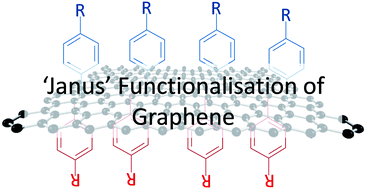Increased chemical reactivity achieved by asymmetrical ‘Janus’ functionalisation of graphene†
Abstract
Chemical functionalisation is a promising method to tune the electronic structure of graphene, and the two-dimensional structure of graphene enables access to both of its faces for various types of functionalisation. Here, we present the effect of covalent functionalisation on the Raman spectrum in terms of monofacial (one-sided) and bifacial (two-sided) functionalisation using both monolayer and bilayer graphene. Asymmetrical or ‘Janus’ functionalisation is found to provide significantly increased levels of doping compared to other schemes allowing for control over graphene's electronic structure as well as control over surface functionality.


 Please wait while we load your content...
Please wait while we load your content...